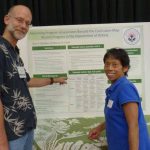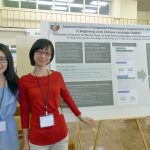Assessment for Advising
In the last few years, the need has increased at UHM for students to more actively engage in …


In the last few years, the need has increased at UHM for students to more actively engage in …
This poster will have a strong descriptive element of the process undertaken to assess the doctoral program in …

The Chinese Section at the East Asian Languages and Literatures (EALL) department at University of Hawaiʻi at Mānoa …

The Hawai‘i Rehabilitation Counseling program (HRC) at the University of Hawaiʻi at Mānoa (UHM) prepares graduate students to …

The Filipino program has engaged in assessment activities in the past but these efforts are limited and uncoordinated. …

To address the 2013 Interstate Teacher Assessment and Support Consortium (InTASC) Model Core Teaching Standards and Learning Progressions …

The Intercollege Nutrition PhD Program is a relatively new program, begun in Fall 2007. The Program has recently …

This poster describes the program’s project to develop doctoral level program learning outcomes mapped to required courses and …

The mission of the instruction program in FDM is to provide students with appropriate knowledge and skills for …

This poster is going to present how faculty in the Academy for Creative Media undergraduate program utilized an …

This poster will present the results of efforts to develop a robust program for assessment of the graduate …

Swine Production is a senior capstone course in which students integrate concepts learned in courses such as nutrition, …

This study was intrigued by the needs to assess oral performance more systematically and to motivate students to …

In the last 6 months, the Department of Psychology has initiated a new plan that is expected to …

In fall 2014 and spring 2015 the Botany faculty at the University of Hawaiʻi at Mānoa devised programmatic …

In Spring 2008, the English Department began assessment of student writing for the University’s Foundations Requirement in Written …

The poster gives the Assessment Tools that we use in our department to assess our department Program Objectives …

LILO (Learning Information Literacy Online) is a project of the UH Libraries Information Literacy Committee (UHLILC) for the …

The poster gives the Assessment Tools that we use in our department to assess our department Program Objectives and …
The Food Science and Human Nutrition (FSHN) Undergraduate program has established an ad-hoc committee to assess written communication …
The faculty of Hawaiian Studies (HWST) developed a blended assessment plan for our undergraduate program over the past …
Student learning outcome (SLO) statements made by an educational program serve as targets for achievement and openly communicate …
Scholarship on language teacher education emphasizes teaching language skills. Yet preservice language teachers must learn more than grammar …
This project presents a signature assignment for Indo-Pacific culture courses to assess the students’ cultural competency by discussing …
This workshop is co-sponsored by the Assessment and Curriculum Support Center, Graduate Division, and the Graduate Council. Wondering …

This poster outlines the process through which faculty examined how the embedded assignments, field components, and signature assignment …
We would like to share your rubric too. Please email it to us. Repository of Graduate Program Rubrics …

The poster will describe the process that the dietetics program faculty and staff underwent to develop a systematic …

The poster describes the content mapping process that aligned the learning priorities in the problem-based-learning pre-clerkship medical curriculum …

This poster describes a systematic process of developing the assessment of student professionalism in Speech-Language Pathology. The process …

We demonstrate how faculty use efficient and effective assessment of learning to improve the written and oral communication …

This project was to increase the learning and the assessment capabilities in two core Child and Family courses. By …

This poster describes the effort of the Ph.D. Committee in Social Welfare in investigating and improving students’ performance …

The poster describes the steps and resulting standardized student admission procedure for the Communication Sciences and Disorders’ Master …

A process to conduct an overhaul of the JABSOM curriculum map of the medical education program was conducted, …
In this workshop, participants will learn about finding good examples of rubrics to adapt or adopt; working with …
In this workshop, the presenters will discuss how to use a rubric for program assessment, and how to …
This workshop lets participants evaluate their programs’ learning outcomes (SLOs) related to critical thinking, problem solving, oral communication, …
In this workshop, participants will learn how to construct and use rubrics to save time and engage students …

Exploring possibilities for, and effects of, Integrated Performance Assessments (IPAs) in the Department of East Asian Languages and …

This poster describes strategies to build faculty capacity in curriculum design and alignment and ways to plant the …

The undergraduate programs from two departments, Tropical Plant and Soil Sciences (TPSS) and Plant and Environmental Protection Sciences …

It is often hard to gauge the performance of a graduate student in a timely manner, or provide …

The Myron B. Thompson School of Social Work (SW) PhD program at the University of Hawaiʻi at Mānoa …

This poster features the development and use of a rubric for program assessment. The Nursing PhD program at …

Pacific Island Studies at the University of Hawaiʻi at Mānoa has 6 teaching faculty and 20 majors enrolled …

The Ocean and Resources Engineering (ORE) Department at the University of Hawaiʻi at Mānoa (UHM) is a small, …

The Communication Department’s mission is to meet the challenges and opportunities of communication in the emerging technological, multicultural, …

Observing that many faculty within the Theater Department at the University of Hawaiʻi at Mānoa lacked a strong …

The Sociology Department at the University of Hawaiʻi at Mānoa (UHM) made significant changes to program assessment during …

At the University of Hawaiʻi at Mānoa, the Department of Biology is comprised of over one thousand undergraduate …
Last Updated: 4 March 2024. Click here to view archived versions of this page. On this page: Note: The …